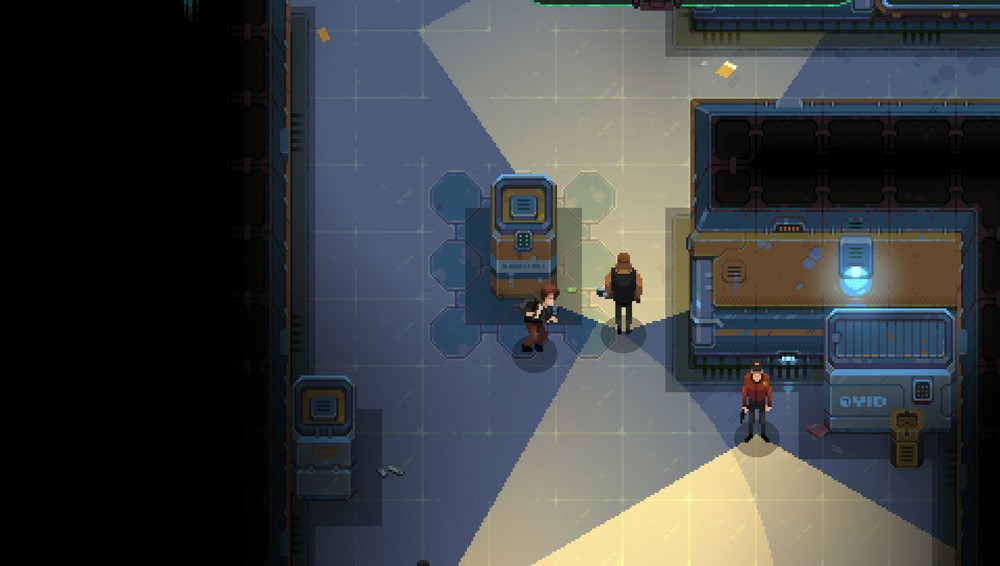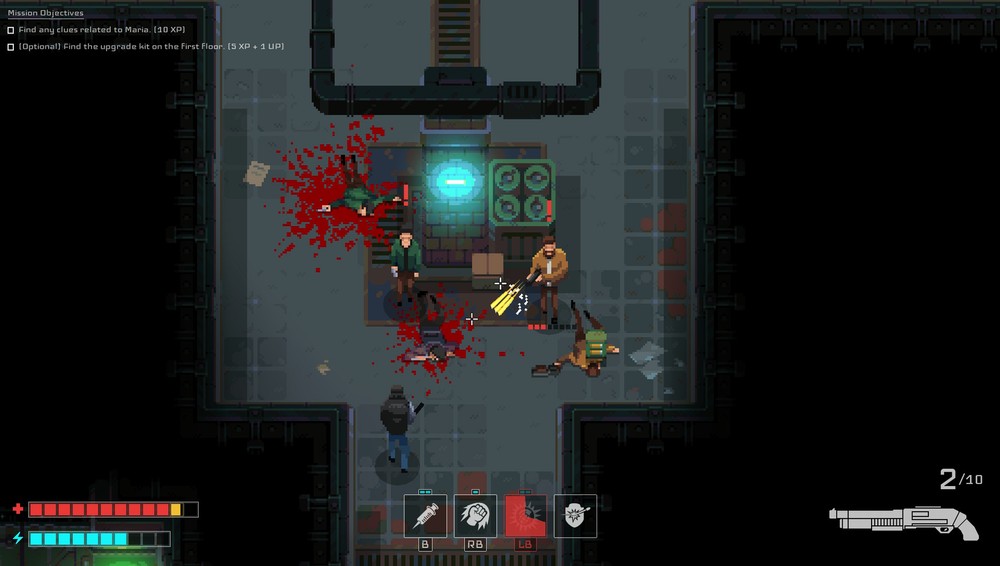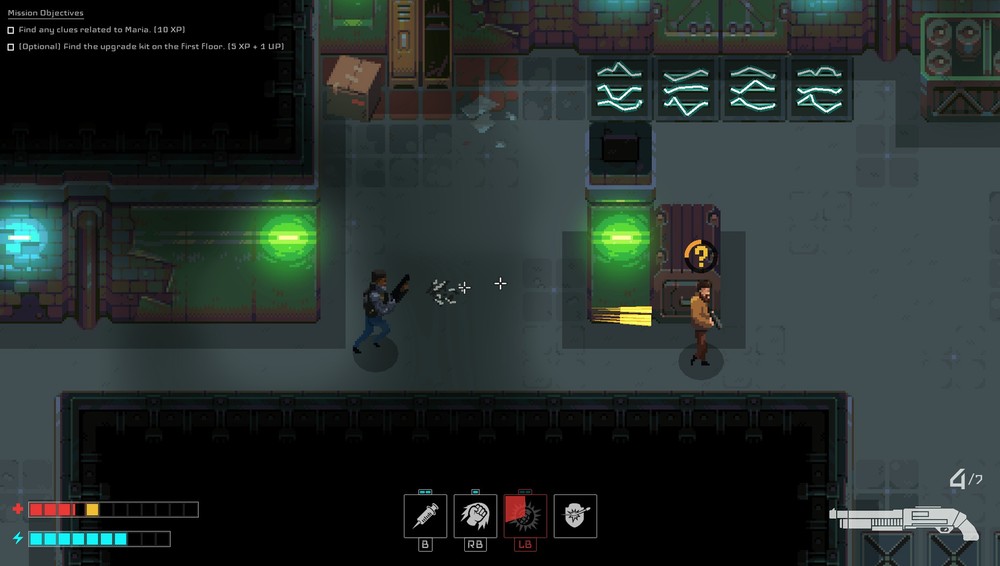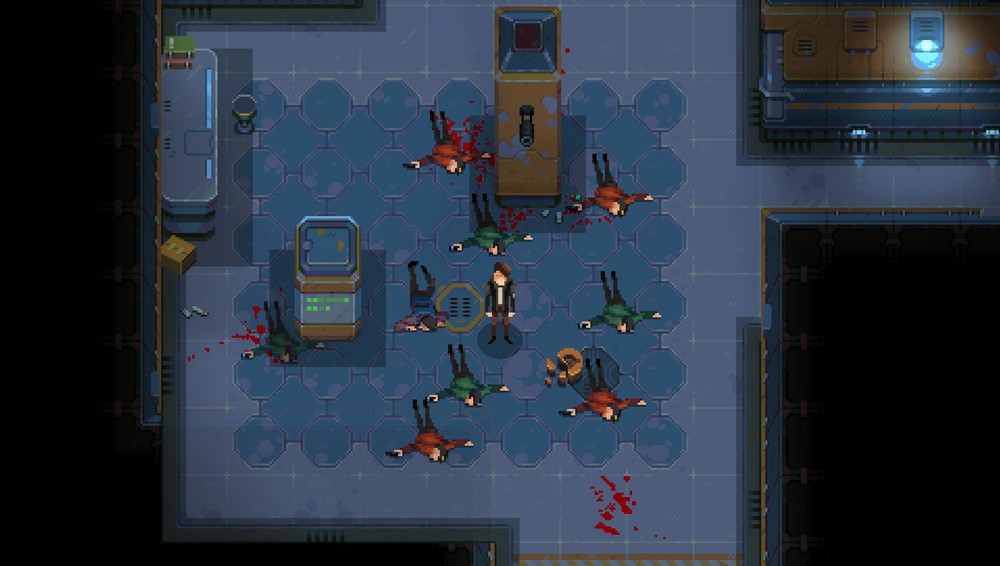Just when you thought the cyberpunk genre was about to die (just kidding) Ape Tribe Games stokes the flames with their new stealth-action RPG, Disjunction. Set in 2048 in the seedy underworld of New York, you will play as three unique characters with three intertwining stories dealing with city corruption, murder, and a new drug called Shard that is ravaging the city. Each character has their own style and progression tree of upgrades and talents to create a dynamic mix of stealth and action gameplay.
You’ll start off playing as Frank, your classic private investigator, then switch off to Joe, a cybernetic enhanced boxer with a metal arm and jaw, and finally Spider, a gifted hacker that uses her tech skills to enhance her combat. Disjunction is designed so that you could technically play the game without killing anyone. In fact, early on Frank gets yelled at over the phone if/when you do kill some guards. Enemies like robots, drones, and sentry guns don’t count, but using your weapon at any time has a good chance of attracting human opposition. Additionally, at the end of each chapter you usually come to a boss where you can make the decision to kill them, turn them over to the police, or simply walk away.
 Pixel art is definitely not one of my favorite styles. I didn’t spend two month and hundreds of dollars furiously trying to purchase my RTX3080 card to play games that look like the stuff I played in the 80’s, but Disjunction actually pulls it off with some slick design aesthetics, quirky sprite animation, and some nice visual effects. Presented in a top-down view with a hint of 3D depth, the game reminded me of the classic, Gauntlet. A detailed map of the level will slowly materialize as you explore the maze of corridors and rooms on each of the two levels that make up each mission. In additional to simply reaching the end of each level you will also need to seek out keys and the optional upgrade kit stashed somewhere – usually on level 2. There are also pickups for energy and ammo as well as a single checkpoint per map that can add a great deal of tension knowing that if you die you might respawn and have to repeat as much as 10-15 minutes of gameplay.
Pixel art is definitely not one of my favorite styles. I didn’t spend two month and hundreds of dollars furiously trying to purchase my RTX3080 card to play games that look like the stuff I played in the 80’s, but Disjunction actually pulls it off with some slick design aesthetics, quirky sprite animation, and some nice visual effects. Presented in a top-down view with a hint of 3D depth, the game reminded me of the classic, Gauntlet. A detailed map of the level will slowly materialize as you explore the maze of corridors and rooms on each of the two levels that make up each mission. In additional to simply reaching the end of each level you will also need to seek out keys and the optional upgrade kit stashed somewhere – usually on level 2. There are also pickups for energy and ammo as well as a single checkpoint per map that can add a great deal of tension knowing that if you die you might respawn and have to repeat as much as 10-15 minutes of gameplay.
The story determines which character you play and while gameplay is essentially the same for all three, the way you tackle certain situations can vary. I tried to keep things non-lethal with Frank, but when Joe took over it was all about the shotgun and shock grenade rampage. Spider was super-stealthy with a cloaking device that grants a few seconds of invisibility and a holographic distraction to move guards out of the way. Everyone has a passive ability along with three primary abilities that require various amounts of energy. A dash/stun move costs a single unit of energy while healing yourself costs four. It’s a clever system that keeps you from spamming the healing, and encourages thoughtful use and strategy for deploying these abilities.
 Disjunction relies heavily on stealth gameplay…until it doesn’t. When you crouch you go into a silent/slower movement and vision cones appear for all the enemies including robots, cameras, and sentry guns. As long as you stay out of the yellow zone you are free to sneak around and either avoid enemies or get up close and do a melee takedown. Some enemies are tougher than others and might need 2-3 swipes. If other guards are on a patrol route you might want to pick-up and hide the body. It’s also worth noting there are environmental hazards like shock panels on the floor that you must run across rather than sneak, which of course means loud footsteps that could trigger guards. One nice feature is the ability to pan the camera around your current view, allowing you to see enemies just off the edge of your screen.
Disjunction relies heavily on stealth gameplay…until it doesn’t. When you crouch you go into a silent/slower movement and vision cones appear for all the enemies including robots, cameras, and sentry guns. As long as you stay out of the yellow zone you are free to sneak around and either avoid enemies or get up close and do a melee takedown. Some enemies are tougher than others and might need 2-3 swipes. If other guards are on a patrol route you might want to pick-up and hide the body. It’s also worth noting there are environmental hazards like shock panels on the floor that you must run across rather than sneak, which of course means loud footsteps that could trigger guards. One nice feature is the ability to pan the camera around your current view, allowing you to see enemies just off the edge of your screen.
Between missions you will get to enhance your character by spending points to boost health and combat abilities, as well as spending earned XP to unlock abilities on the talent tree. This is where those mid-mission upgrade kits come in handy, but what is really nice is that you can re-spec your characters before each mission, so if one upgrade or talent didn’t work the way you wanted you can try something else with no penalty.
 Disjunction tries to tell a story mostly through unspoken dialogue trees and lots of hyperlinks that will pop-up insane amounts of detailed backstory and definitions when you click on the orange text. You’ll even find news clippings, magazine articles, and research documents during the mission that provide even more flavor at the expense of reading a half-page of text in the middle of sneaking around. There is no spoken dialogue leaving the audio experience in the hands of Dan Farley who has crafted a magnificent soundtrack. His atmospheric score really enhances the way you feel while playing Disjunction and is sold separately or bundled with the game. There are also some classic retro sound effects for weapons, robotic footsteps, doors opening, etc. that all fits perfectly with the visuals.
Disjunction tries to tell a story mostly through unspoken dialogue trees and lots of hyperlinks that will pop-up insane amounts of detailed backstory and definitions when you click on the orange text. You’ll even find news clippings, magazine articles, and research documents during the mission that provide even more flavor at the expense of reading a half-page of text in the middle of sneaking around. There is no spoken dialogue leaving the audio experience in the hands of Dan Farley who has crafted a magnificent soundtrack. His atmospheric score really enhances the way you feel while playing Disjunction and is sold separately or bundled with the game. There are also some classic retro sound effects for weapons, robotic footsteps, doors opening, etc. that all fits perfectly with the visuals.
There is a demo you can try if you want to see if Disjunction might be right for you. I’m not sure how much content it covers, as it took me nearly six hours to reach the third character and play her initial levels. I will say the levels are rather short, at least when looking at the maps, but the clever use of key placement and enemies that need to be avoided or killed will add considerable playtime. The way you play the game seldom varies, so things can get repetitive if you try to play too much of Disjunction in one sitting. Assets are shared across maps and while some textures and sprites vary in color and detail not much changes between the first and last levels of this game. They do mix in day and night elements, which basically determine the color of the clouds outside the level map and any light that might be streaming through the window.
 Pixel art games always boggle my mind, as it seems it would take more effort to create something identifiable and pleasing to the eye out of blocks, but perhaps that is the challenge. As someone who grew up with Sierra and LucasArts games, Disjunction took me back to the 80’s where all the games looked like this. I really dug the cyberpunk vibe, atmospheric soundtrack, and dynamic gameplay across the three characters. Yes, the game is repetitive if played for too long, but there is just enough story here (should you choose to read it all) that will keep you entertained until the end.
Pixel art games always boggle my mind, as it seems it would take more effort to create something identifiable and pleasing to the eye out of blocks, but perhaps that is the challenge. As someone who grew up with Sierra and LucasArts games, Disjunction took me back to the 80’s where all the games looked like this. I really dug the cyberpunk vibe, atmospheric soundtrack, and dynamic gameplay across the three characters. Yes, the game is repetitive if played for too long, but there is just enough story here (should you choose to read it all) that will keep you entertained until the end.











